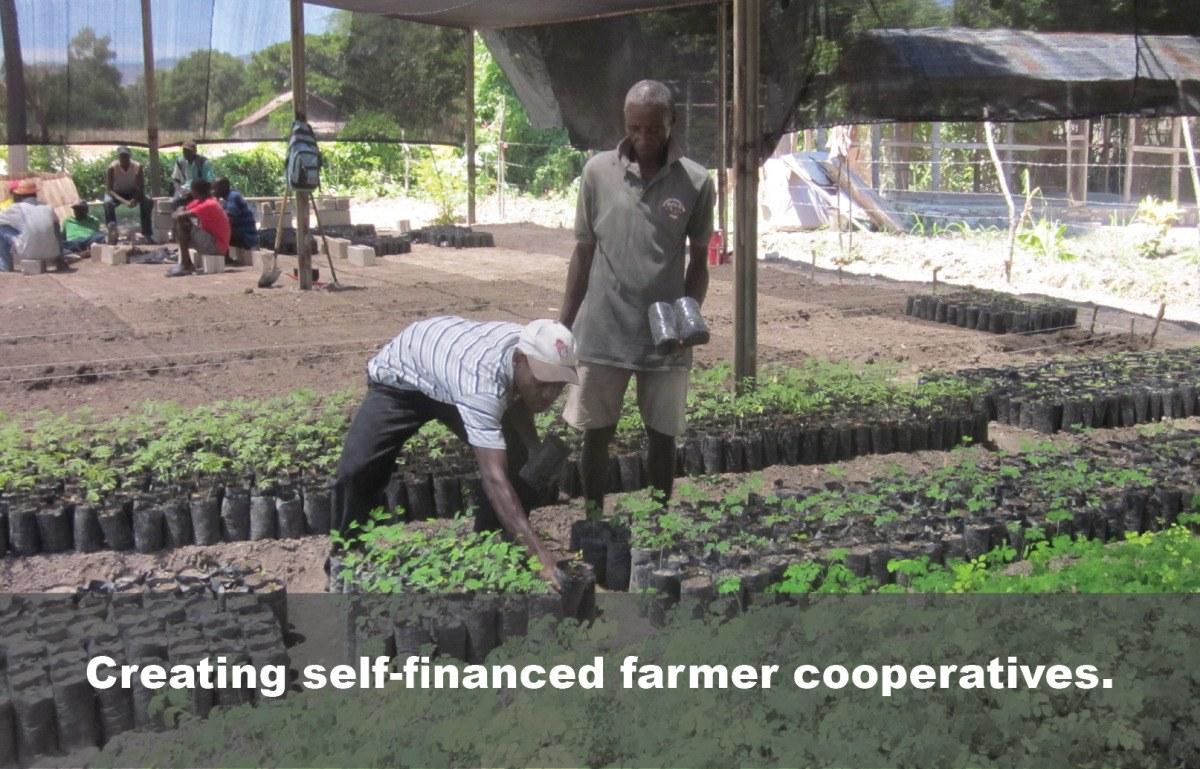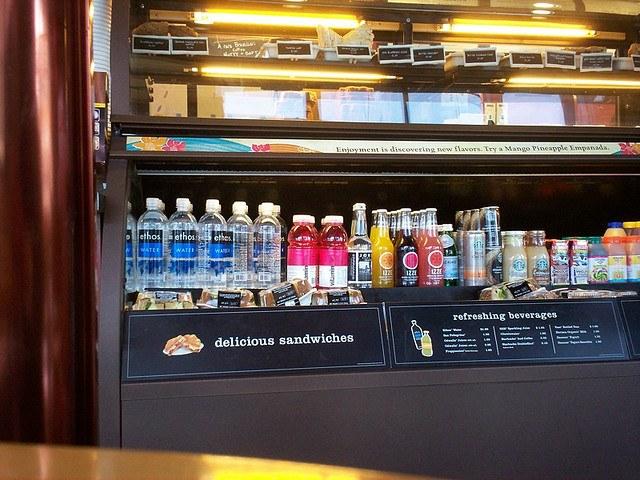Smallholder Farmers: The New Global Food Frontier


Back in January, 3p reported on an innovative community agroforestry development project that is having tremendous success revitalizing rural smallholder farms and communities in rural Haiti. With steadfast support from Timberland, as well as the rural communities in which it works, the Smallholder Farmers Alliance (SFA) is helping smallholder farmers and communities in northern Haiti raise crop yields, reforest a nation that's suffered from the highest rate of deforestation in the Western Hemisphere, and improve their livelihoods and overall well-being.
SFA-Timberland's five-year agroforestry project highlights the vital role smallholder farms and communities play in sustaining the socioeconomic and ecological fabric of countries the world over. It also highlights the tremendous, triple-bottom-line benefits that can be realized with relatively little in the way of capital and other resources; in lieu of sufficient funds, success can come by employing an innovative model of sustainable development that affords local residents ownership of for-profit ventures based on “sweat equity.”
SFA is now taking its message worldwide. “One-third of the world's 7.3 billion people are smallholder family farmers who produce nearly 70 percent of all food consumed worldwide. So, why aren't we doing more to protect them?” reads the news “hook” for an article written by SFA co-founder and president, Hugh Locke, published in the Guardian on May 13.
Lifting smallholder farms and communities out of poverty
Even though they cultivate 60 percent of the world's arable land and produce 70 percent of the food we eat, smallholder farmers are among the most impoverished people on earth, Locke points out in his Guardian article, saying “smallholder farmers are the new global food frontier.”
Oddly enough, the plight and impoverishment of the world's 2-plus billion smallholder farmers has its roots in the “Green Revolution” that took root back in the 1960s. Experts predicted world population would exceed food supply by the 1990s, unleashing a massive wave of investment in industrialized agriculture that saw intensive fossil and synthetic fertilizer-fueled agricultural development that spread from developing to developed countries around the world.
“About the same time as the initial food scare, rich countries began giving foreign aid to developing countries to improve their economies and reduce poverty. Part of the deal was that recipient nations had to agree to reduce support for domestic smallholder agriculture and encourage their citizens to buy cheap imported grain from industrialized farms in the countries giving the foreign aid,” Locke recounts.
Supported by the theorized, statistically-complicated economic notion of competitive advantage, this quid pro quo has sent smallholder farms, families and communities across the developing world into poverty. Ironically, it was precisely such groups of people that played key roles in the forging of developed-country economies and societies.
As Locke writes: “The combination of a vast increase in industrial farming and greatly reduced support for agriculture in developing countries led to smallholder farmers becoming invisible.
“Today, there are 2.5 billion people who live and work on 500 million smallholder farms, each less than two hectares (five acres). They represent one-third of humanity, yet they have been systematically ignored and marginalized for 60 years, while industrial farming has received the benefits of agricultural research, subsidies, trade agreements, tax credits and regulatory systems.”
Supporting smallholder farms: The new global food frontier
The same food scare-tactics and logic are being used today to push for more industrialized, high-tech agriculture that benefits multinational corporations and investors at the expense of smallholder farms across the developing world. Large sections of so-called free-trade agreements, such as NAFTA and the Trans-Pacific Partnership (TPP), are typically devoted to furthering its spread.
“Experts are now telling us there will be 2 billion more people by 2050, but not enough food to feed this increased population if we stay at current production levels. Almost all of these new people will be born in low-income countries where food is produced on small farms," Locke writes."In an ironic twist, this new global food scare is putting smallholder farmers on the radar for the first time. Having reached the limit of arable land worldwide, our only option is to figure out how to increase yields on land already being cultivated. Given that more than half of all farmland is cultivated by smallholder farmers, they have become the new global food frontier.
Unexpectedly, smallholder farmers have found a strong new ally in the growing number of major multinational food and beverage companies that come out in support of a new model of sustainable agricultural development, Locke continues. That's a development that 3p has reported on extensively in its coverage of sustainable agriculture.
“Major companies within the food and beverage industry, typically for business reasons, have begun procuring from millions of smallholder farmers throughout the developing world. In less than a decade, this market-based partnership between smallholder farmers and corporations has in some ways done more to benefit the farmers than 60 years of foreign aid,” Locke writes.
“The food and beverage industry is now in a leadership role it did not ask for. More significantly, they are in a unique position to be the catalyst for a global course correction that goes beyond just helping smallholder farmers.”
*Image credits: 1)Timberland-SFA; 2), 3) SFA
4 Unsung Environmental Benefits of Online Education


By Dennis Hung
Online learning is an excellent educational option that offers convenience, reduced costs and a personalized experience. It is estimated that almost half of all students will take an online course at least one time during their lifetime. Over 40 percent of Fortune 500 companies use some form of online educational technology for employee training. Common courses among large enterprises are CCNA Data Center Training and other forms of system administration. According to IBM, online learning can boost productivity by up to 50 percent.
Telecommuting started to become popular during the 1990s. Employers quickly discovered that they could both reduce costs and increase employee satisfaction through allowing them to telecommute to work. Online learning offers similar benefits to the organization and individuals involved. However, there are extra benefits to online learning for the environment.
Online learning reduces the negative environmental impacts that come from manufacturing and transportation. The materials needed for traditional education institutions (textbooks, desks, electricity, buildings) are dramatically reduced. This reduces waste and conserves natural resources. Additionally, online learning saves money and time for both the learning institution and the student.
Here are four more things you'll save by choosing online learning:
1. Gas
American towns and cities tend to be decentralized. That is, residential, commercial, government and educational buildings are spread out to ensure proper urban growth. However, the downside is that the average American uses up to 600 gallons of gas a year. Much of this waste comes from speeding, waiting in traffic and idling the car in park while texting. Students who travel every day for just a few classes’ waste gas and natural resources. Online learning allows the student to learn from the comfort of their home while avoiding wear-and-tear on their vehicle and local roads.
2. Pollution and emissions
One study by the University of West Georgia revealed that for every 100 students who did not commute to school, carbon dioxide emissions were reduced by up to 10 tons every semester. Another study by the Stockholm Environmental Institute (SEI) showed that online learning courses resulted in a 90 percent emission reduction. The study specifically found that the average full-time traditional student created roughly 180 pounds of CO2 emissions, compared to only four pounds for an online student.
3. Natural resources
Buildings use large amounts of energy for power and heat. Energy consumption for students in regular classroom creates a CO2 equivalent of over 220 pounds, compared to only 10 pounds for an online student. The U.K.'s Open University Design Innovation Group (DIG) found that online learning consumes up to 90 percent less energy compared to traditional sources. In addition to this, constructing schools and educational institutions need plastic, metal, wood and other building materials. Online education reduces the demand for these raw goods which protects the environment.
4. Paper
Deforestation is a serious global issue. According to the National Wildlife Foundation, 60 percent of school waste is paper. One ton of paper waste is equal to 16 large trees. Recycling 10 tons of paper is equal to the use of up to 100 barrels of crude oil. The traditional education system notoriously over-uses “busy work,” which is a chronic source of paper waste. Online learning even reduces the energy and resources used to recycle paper.
Online education is an excellent way to save paper because the curriculum, assignments and even textbooks are all digital. Rio Salado College in Tempe, Arizona, started an innovative program called the Textbook Savings Program. This has reduced student’s costs by over 50 percent. Finally, administration paperwork, registration, finances can all be done through online portals.
Image credits: Stock images
Dennis Hung is a business and technology consultant. He’s passionate about conservation and spends much of his time out of the office promoting conservation best practices.
Human Capital Impact of Educational Institutions


By Meghna Tare
Human capital is a collection of resources — knowledge, talents, skills, abilities, experience, intelligence, training and judgment -- possessed individually and collectively by a community. These resources are the total capacity of the people, which represents a form of wealth that can be directed to accomplish the goals of the nation or state.
Human capital is just as important in the nonprofit sector as it is to businesses and nations, which is why human capital investments such as education and training are a driving force and area of interest for individuals, firms and governments as it is a major factor in generating future growth and prosperity. Colleges and universities are increasingly viewed as engines of local economic development. Conventional approaches to valuing the economic activity generated by colleges and universities often focused on direct employment or expenditure effects, along with a multiplier effect to capture indirect and induced outcomes.
However, the potential influence of colleges and universities goes beyond these standard effects for an important reason. These institutions can help build the knowledge and skills — or human capital — of a region’s people, a critical component of an area’s economic success. A region with higher levels of human capital tends to have greater amounts of economic activity and more rapid economic growth. In addition, its workers tend to be more productive and earn higher wages. The total effect of higher levels of human capital on economic activity is larger than the sum of its parts. The geographic concentration of human capital facilitates what economists refer to as “knowledge spillovers”—the transfer of knowledge and skills from one individual to another.
One such example of a university creating human capital impact is University of Texas at Arlington (UTA) with a campus that spans 420 acres and 110 buildings with more than 180 degree programs, and record spending of $77.7 million on R&D in 2013. UTA improves higher education delivery throughout the state and helps students increase their employability and potential. By facilitating new research and drawing students and visitors to Texas, the university also generates new dollars and opportunities for the state. In the fiscal year 2013, $493.3 million in payroll and operations spending of UTA, together with the spending of its students, visitors, and former students, created $3.4 billion in added state income. This is equal to approximately 0.30 percent of the total gross state product (GSP) of Texas, and is equivalent to creating 52,341 new jobs. The accumulated contribution of former students of UTA currently employed in the state workforce amounted to $2.9 billion in added state income for the Texas economy, which is equivalent to creating 44,460 new jobs. For every dollar that society spent on educations at UTA, Texas communities will receive a cumulative value of $5.80 in benefits.
Texas as a whole spent an estimated $1.3 billion on education at UTA in FY 13. This includes $493.3 million in expenses by UTA, $35 million in student expenses, and $778.6 million in student opportunity costs. In return, the state of Texas will receive an estimate present value of $6.8 million in added state income over the course of the student’s working lives. Texas will also benefit from an estimated $791.7 million in present value social externalities related to reduced crime, lower welfare and reduced unemployment, and increased health and well-being across the state. Health savings include avoided medical costs, lost productivity, and other effects associated with smoking, alcoholism, obesity, mental illness, and drug abuse. Crime savings consists of avoided costs to the justice system. Welfare and unemployment benefits consists of avoided costs due to the reduce reliance on social assistance and unemployment insurance claims.
The amount of human capital in a region is a key determinant of its economic vitality and long-run economic success. As the U.S. economy continues to shift away from manufacturing and the distribution of goods toward the production of knowledge and ideas, the importance of human capital to a region will only grow.
Note: The Economic Modeling for UTA was conducted by EMSI.
Image credit: University of Texas at Arlington
Meghna is the Executive Director, Institute for Sustainability and Global Impact at the University of Texas at Arlington where she has spearheaded many successful projects related to policy implementation, buildings and development, green procurement, transportation, employee engagement, waste management, and GRI reporting. She is a TEDx UTA speaker, was featured as Women in CSR by TriplePundit, has done various radio shows on sustainability, and is an active blogger. She has a sunny and positive attitude about life and all of its adventures. You can connect with her on LinkedIn or follow her on Twitter @meghnatare
FoE report highlights eco-impact of everyday products


A new report from Friends of the Earth (FoE) estimates for the first time how much land and water well-known brands such as Apple, Kraft and Gap use in a year, and what is needed to manufacture some of the products they sell.
Based on modelling by environmental data company Trucost, the ‘Mind your step’ report examines the land and water ‘footprints’ of a range of diverse products including smartphones, leather boots, coffee, chicken curry ready-meals, t-shirts, and milk chocolate.
Trucost’s calculations also indicate the extent to which often controversial stages in the manufacture of these products - such as mining for metals and minerals, and water pollution from electronics assembly factories - contribute to these water and land footprints.
Former European Environment Commissioner Janez Potocnik commented: “The estimates provided in the report are extremely useful reminders of how heavily we currently tread on the world. More than that, in a world of fragile economies and environments, they are signposts to how we can tread more lightly, while continuing to grow our economies and improve the wellbeing of our citizens.”
Read the full report here.
China sets example with marked reduction in CO2 emissions


Official data from China shows it is cutting coal and CO2 emissions faster than any other country. Indeed, Greenpeace says the CO2 reduction could be equal to UK total emissions over same period.
An analysis of the data by Greenpeace/Energydesk China suggests coal consumption in the world’s largest economy fell by almost 8% and CO2 emissions by around 5% in the first four months of the year, compared with the same period in 2014.
John Sauven, executive director of Greenpeace UK, commented: “While China has historically been used as an excuse not to act on climate change, now we are beginning to see China as the example of why we should act on climate change. The drop in emissions from coal shows that the progress made on alternative energy and energy efficiency is beginning to kick in.
"While some of the drop may be caused by slower GDP growth, the majority is clearly government action to curtail coal use and rebalance the economy. China’s drop in emissions is a timely message to the rest of the world ahead of climate talks in Paris in December.”
Scotland to host inaugural Global Ethical Finance Forum


Hosted by the Scottish Government, the Global Ethical Finance Forum (GEFF) in September is being hailed as an historic initiative, in conjunction with the Islamic Finance Council UK (IFC UK) and Thomson Reuters. It aims to be a platform to connect the large, but fragmented, ethical / responsible finance and investment communities.
The event will mark the launch of the Responsible Finance Institute (RFI) which will act to engage the industry in a dialogue which will result in increased opportunities for convergence and collaboration.
Sarah Marten, ceo of the RFI, commented: “GEFF's objectives are to harness the collective strengths of the various forms of responsible finance and investing (inclusive of Islamic finance) that together comprise more than US$11 trillion dollars.”
She added that global sustainable development challenges such as climate change and poverty line cannot be addressed successfully without responsible finance that integrates ESG concerns into the financing and investment decision making of financial institutions.
Thomson Reuters has chosen the Forum for the exclusive launch of the Responsible Finance Report, produced in collaboration with the RFI.
The report will be the first to rigorously measure the size and geographic concentrations of the entire ethical finance and SRI industry, inclusive of the Islamic banking and finance industry, assess its commonalities and present opportunities for convergence in customers, processes and practices.
GEFF will take place in Edinburgh from 1-2 September 2015.
CVS Sets Example by Taking the High Road on Tobacco Sales


Every now and then, a company takes a bold step, walking away from a profitable line of business because it doesn’t align with their mission. Retail pharmacy chain CVS took such a step last year when it decided to stop selling tobacco products. I asked Eileen Howard Boone, SVP of corporate social responsibility and philanthropy at CVS, to help us to better understand the thinking behind this decision.
"Consider the statistics: 480,000 people die each year from tobacco-related illness; 42 million American adults and 3 million middle- and high-school students continue to smoke," Boone told us. She went on to say that contributing to these shocking statistics clearly conflicts with the company's purpose of "helping people on their path to better health." Moreover, it poses "a significant threat to public health."
While she said there were many factors the company considered in making the decision, “in the end, it was just the right thing to do for the health of our colleagues and our customers."
Taking a short-term hit for long-term benefit
What makes this statement unusual is the fact that, by making it, the company is walking away from approximately $2 billion in annual tobacco sales, not to mention additional sales of health care products and services to all the people who become sicker as a result of smoking.
Boone calls the move as an investment. "This was a long-term decision that our board, our senior leaders and our stakeholders all agreed was in line with where we expect to be as a health care company in the future."
Clearly the company is positioning itself in line with perceived opportunities. This includes the aging demographic, the continuous parade of medical advances, the increasing cost and complexity of the health care delivery system, and growing health consciousness among consumers.
"Now more than ever, pharmacies are on the front line of health care, becoming more involved in chronic disease management to help patients with high blood pressure, high cholesterol and diabetes," Boone said."All of these conditions are worsened by tobacco use. As a pharmacy innovation company, we have the unique capability of aligning our 26,000 CVS/pharmacy pharmacists, our leading Pharmacy Benefits Management services, and our nurse practitioners at nearly 1,000 MinuteClinics to help people lead tobacco-free lives and manage their health."
But for CVS, taking action to help reduce smoking "was not just about removing cigarettes from our stores," Boone told 3p. "We also wanted to support smokers’ efforts to quit. That’s why we launched a uniquely personalized and comprehensive smoking cessation campaign designed to help smokers quit.
Going a step further: Smoking cessation
"Our innovative smoking cessation program taps our entire chain of CVS/pharmacy stores, our MinuteClinics and our leading administrator of prescription drug benefit coverage. These resources are supplemented with information online at as well as a smoking quit line operated by the American Cancer Society for additional support and access to services in local communities."
The program appears to be gaining traction. From its launch on Sept. 3, 2014, through December 2014, CVS pharmacists counseled more than 67,000 patients filling a first prescription for a smoking cessation drug or prescription nicotine replacement therapy (NRT), and consulted with thousands more smokers seeking advice about over-the-counter NRT products. In addition, prescriptions for smoking cessation medications and visits to MinuteClinic for smoking cessation counseling increased on a monthly basis from the prior eight months. Purchases of over-the-counter NRT products that assist smokers trying to quit increased by 21 percent in that timeframe compared to the previous four months. And, customers picked up 2.3 million tobacco cessation brochures at CVS/pharmacy and thousands of “Last Pack” encouragement toolkits, reaching millions of additional smokers with education, information and support.
The company has taken its fight against tobacco beyond its stores as well. CVS Health Foundation recently launched a five-year, $5 million commitment to the Campaign for Tobacco-Free Kids for a new "Making the Next Generation Tobacco-Free" grant program.
Through the program, the CVS Health Foundation is partnering with Tobacco-Free Kids to provide grants to organizations across the country that are committed to implementing public health strategies to reduce youth tobacco use and exposure to secondhand smoke. Grants will support programs that help to reduce youth tobacco use, especially among at-risk populations, educate the public about the problem of and solutions to youth tobacco use in local communities, and increase youth engagement in tobacco prevention activities.
Image credit: 1) Flickr/Matt McDaniel 2) Flickr/Curran Kelleher
Levi’s Employees Are Science Teachers for a Day


Ask anyone who has children or has spent time around young ones, and they’ll tell you that kids love to remember random facts. That’s why it’s perfect that Levis Strauss & Co. has partnered with Project WET Foundation to develop custom water education curriculum and train Levi’s employees to teach young students about water conservation – a pilot program which employee volunteers kicked off last week as part of the company’s Community Day.
Called “water ambassadors,” Levi’s employees from San Francisco, Shanghai and Singapore were trained by Project WET to go into classrooms and teach students around the world about their water footprints, all while promoting water literacy and awareness.
Through a series of interactive lessons, students learned facts – such as the number of liters used to grow cotton (2,565 liters), the percentage of Earth’s surface covered by water (71 percent) and the amount of water on the planet that is actually potable fresh water (0.003 percent) – and were given handouts to learn more about the lifecycle of a jean and how to conserve water at home.
“As a company, water is a big priority for us,” said Michael Kobori, VP of sustainability at Levi Strauss & Co. “Bringing water conservation and sustainability into the classroom is a natural extension of our company’s focus on water. This [program] gets young people to be more aware of water issues and is also a way to activate our employee base.”
The LS&Co. Water Ambassador program – a stellar model for the intersection between sustainability, employee engagement and consumer education – is just the latest example of the company’s proactive approach to promoting water conservation.
Teaching water stewardship
The company's water education efforts go far beyond the classroom. In 2011, Levi’s launched its Water<Less jean collection, a line of products that uses 96 percent less water in the finishing process and has helped the company save 1 billion liters of water to date. Through its partnership with the Better Cotton Initiative, the company is also promoting water conservation, reduction in pesticide use and improved child labor practices within the cotton industry.
With the new Water Ambassador employee volunteer program, Levi Strauss is bringing water conservation education to the next generation.
“Kids are the ones who are going to make the decisions about how our water is managed in the future,” said Morgan Close, international program manager at Project WET. “Levi’s has so many employees around the world ... Now they can teach kids how to be water stewards, and the kids can take what they learn and teach others. Kids can become change agents and be the catalyst to make changes at home.”
Consumer education and engagement
The drive to teach kids about water issues is part of the company’s larger goal to educate consumers about their role in creating a product's ecological footprint. According to the company's lifecycle assessment, consumer use accounts for about 23 percent of the total water used over the lifetime of a pair of Levi’s 501 jeans.
To raise consumer awareness and inspire water conservation, in 2009 Levi Strauss added a “Care Tag for Our Planet” to its products, and last year CEO Chip Bergh made headlines when he encouraged consumers to stop washing their jeans – a practice that has been further promoted with the company’s #WashLessPledge campaign and online LCA Quiz.
A culture of giving back
Beyond highlighting Levi Strauss’ focus on water conservation, the company’s Water Ambassador program also underlines the company’s deep-seated commitment to community involvement.
This year’s Community Day marked the 15th anniversary of the company’s annual global day of service, which enlisted participation from other organizations such as the Waterkeeper Alliance, and also gave employees the opportunity to build bicycles, beautify parks and paint schoolyards. In total, Levi Strauss employees in 57 countries volunteered over a year’s worth of volunteer time on that day alone.
All that volunteering goes to show that, as the company puts it, giving back never goes out of style.
Check out the infographic below for more information about Levi Strauss' Community Day impact:
Image credit: Pexels
Freezing the Energy Impact of Data Centers


By Ryan Walker
In today’s modern world, there have been a lot of revolutionary innovations that allow us to live the way we do -- automobiles, electronics ... and air conditioning. Although cooling systems may not be widely considered by the average person, they have perhaps had the greatest influence globally on where and how humans live.
Lets dig a bit deeper.
The advent of cooling systems has resulted in widespread impacts on land use, health and economics. Urbanization and other modern land development patterns would not be possible without air conditioning, especially in those burgeoning desert locales -- think: Phoenix and Dubai. Urban areas trap hot air, creating heat islands. Air conditioning mitigates these effects, allowing higher density. Moreover, before the widespread use of cooling systems at an individual scale, residential buildings were specifically constructed so as to take advantage of weather conditions or water sources. Now, even in very hot climates, houses on a hilltop in direct sun are commonplace.
Cooling systems also have vital health impacts. For example, you have cooling systems to thank for being able to preserve perishable food. And we may be less likely to be hospitalized if we own an air conditioner.
Finally, the global economy now relies on cooling systems as an important cog to maximize efficiency in the supply chain. Climate-controlled warehouses and centers allow for mass production and storage of goods, such as maintaining the integrity of wood products. Buildings and facilities that are too hot and uninhabitable have also been shown to lead to a reduction of output by employees.
So, you can thank air conditioning for many of the luxuries we experience on a daily basis. Now you can add digital data storage to that list, because it also requires a lot of cooling.
The air conditioning and digital data pact
We all take digital data for granted as an easier storage method and one that is more environmentally friendly. We have effectively reduced the need for paper, transportation for data delivery and material items by replacing them with bytes. While that holds true, digital storage requires large inputs of resources, primarily electricity and water. One reason: data centers.
But isn’t all of our data up in the “cloud”? Well yes, but all of that data still has to be stored somewhere physically, creating a need for digital data storage and centralized IT operations facilities -- otherwise known as data centers. According to SAP, data centers are the “brain of the company." Everything from digital documents, to videos and photos, to Facebook posts are stored somewhere, and that place could be anywhere on the planet. It could be an office server or an enormous industrial warehouse.
Think about your computer for a moment. Not a tablet but one with a hard drive. Does it get warm? The answer should be yes. You are instructed in the fine print to store the computer in a cool location. Now if you work in an office setting and have a server, consider where it is located. Typically, servers are located in a room that is kept at a much cooler temperature. Now multiply your home or office data storage needs by millions or even billions of other people. The amount of storage needed is staggering.
Using water to post to the cloud
So, we’ve established that there is tons of data out there that is stored in various-sized data centers. Data centers can be huge, in some cases more than 100,000 square feet of hot machines, and require a lot of cooling power. What do all these systems need to operate their cooling systems? You guessed it: water!
In addition to electricity, of which cooling consumes about a third of the energy at a typical data center, the amount of water used by such facilities is staggering. Amazon indicates that a 15-megawatt center (large, but not atypical) may use up to 360,000 gallons of water a day, almost entirely to supply chillers. The NSA Security Center, of over 1 million square feet, in Utah requires up to 1.7 million gallons of water a day. In terms of water resource depletion, data centers are a huge consumer. As more and more individuals, governments and businesses rely on off-site data storage for day-to-day activities, we need more machines in enormous facilities to store it.
The lesson here is that no resource is free. It seems that many people believe there to be very little resource use tied to technology, aside from the electronic device itself. As we can see with data centers, that could not be further from the truth. While going back to non-electronic storage is not the solution, we should consider that any material use requires some input of natural resources. Therefore, the ability for data centers to reduce water use will be critical to water conservation.
Data centers: A key to water conservation
As fresh water becomes scarcer around the globe, conservation becomes more important. Sustainability is predicated on the availability of water, and the results will be dire if we cannot protect this resource. So, how do we answer this water-usage dilemma?
The first step is probably to pinpoint areas that would be better suited to supporting the center’s needs. Several of the largest data centers are located in one of the drier developed areas of the world – the American Southwest. The largest single collection of data centers in the world, with ongoing expansion, is currently situated in Las Vegas and operated by the Switch Co. And another of the largest centers in the world is located in Phoenix. A real head scratcher, right?
Another focus area should be on the numerous innovative trends in production efficiency. In Quincy, Washington, Microsoft has constructed a water treatment plant at its data center site, which will facilitate water reuse. The plant takes non-potable water and uses it in the data center before returning it to the local aquifer and municipal system. Millions of gallons of water may be saved.
In a similar effort, Google has constructed a water treatment plant at its data center near Atlanta, which takes greywater, treats it for use in the data center and returns it to the nearby river. Google is also working to reduce water usage in its data centers through “free-cooling” techniques. That is, facilities are cooled by systems utilizing outside air or other methods to take advantage of local climate conditions when possible.
At Facebook’s data center in Prineville, Oregon, the company is exercising several methods to reduce water use, including working with local municipalities, using grey water and capturing water droplets that would otherwise evaporate. Perhaps most importantly, Facebook has posted an online dashboard displaying water efficiency for all to see and other data centers to benchmark against.
Yet another organization using new technologies is the NCAR-Wyoming Supercomputing Center (NWSC) located in Cheyenne, Wyoming, which reduces water use through the design of its cooling towers as well as site landscaping, such as native species planting. The center houses data related to earth science and was named “Green” Data Center of the Year in 2013 by Datacenter Dynamics.
These few examples point to a flourishing mass of “green” data centers developing in response to resource conservation needs. At the end of the day, the luxury of digital data and storage provides a lot of value to people as well as the environment. For one, the need for paper or other types of data storage is reduced. Also, digital data can be stored in a much smaller footprint. The convenience of electronic access to data is undeniable, and the wealth of shared information internationally available is a tremendous asset. Overall, digital data storage is a positive feature to sustaining our planet, so long as risks such as water usage can be kept in check.
The current innovations are only the beginning. Businesses see the value in reducing long-term cost while protecting source water (i.e. risk management) and the environment. The building blocks are there for sustainability in the data storage industry. There are promising innovations out there and more coming along every day. Let's hope that path persists and other industries continue the trend to support solutions for water’s sake.
Image credit: 1) Mentora 2) Flickr/Intel Free Press
Ryan Walker is a degree candidate in the Executive Master of Natural Resources (XMNR) program at Virginia Tech, expecting to graduate in May 2015. He currently works for a non-profit land trust, helping to conserve land through acquisition and easement as well as assisting municipalities in land planning for open space preservation, trails, and conservation development.
Starbucks Bottled Water Highlights Sourcing Problems


California is in the midst of a four-year drought, one of the worst in the Golden State’s history. Gov. Jerry Brown declared a state of emergency due to the drought in 2014. This year, he mandated cities and towns reduce water use by 25 percent, the first time the state has ever mandated water reductions. Things are desperate in California, and it took Starbucks a while to realize how desperate the situation is.
Starbucks has a bottled water brand called Ethos Water. This week, the company announced it would move Ethos Water’s bottling operations from California to Pennsylvania. A few weeks ago, Mother Jones published an investigation into Ethos Water, revealing that it is bottled in Merced, California, ranked as being in “exceptional drought,” the worst category, by the U.S. Drought Monitor. This year, the Merced County Board of Supervisors issued a resolution proclaiming the existence of a local emergency due to drought.
Ethos Water sources its water from private springs in the Placer County town of Baxter, which is also ranked as being in “exceptional drought.” In 2014, Placer County Water Agency declared a water shortage emergency in 2014.
“We are committed to our mission to be a globally responsible company and to support the people of the state of California as they face this unprecedented drought,” said John Kelly, Starbucks senior vice president of global responsibility and public policy, in a statement. “The decision to move our Ethos water sourcing from California and reduce our in-store water usage by more than 25 percent are steps we are taking in partnership with state and local governments to accelerate water conservation.”
There is a problem with the location of Ethos Water’s new bottling operations too -- it also is in the midst of a drought. The Pennsylvania Department of Environmental Protection issued a drought watch in March for 27 counties, including the one in which Ethos operates. Although the drought in Pennsylvania is not as severe at California’s, parts of the state are experiencing below-average groundwater levels.
Ethos Water is not the only bottled water brand to source water from areas in California under exceptional drought, as the Huffington Post revealed last month. The San Francisco Chronicle reported this week that a Crystal Geyser Water Co., a private water bottling company, plans to source drinking water from an aquifer that feeds the Sacramento River.
Bottled water should be for emergency purposes only
Why do bottled water companies source from drought-stricken areas? The reason is simple: Too many Americans drink bottled water when they don’t have to drink it. U.S. consumers bought 8.45 billion gallons of bottled water in 2009, according to Food and Water Watch, spending $10.6 billion. Almost half of the bottled water they bought came from municipal water supplies, also known as tap water.
It is time for Americans to wake up and realize that bottled water should be for emergency purposes only. There are folks in California whose wells are going dry, and they are on waiting lists to have either new wells installed or have their wells drilled deeper. Out of necessity, they are using bottled water. The same goes for people facing a natural disaster or whose water has a terrible taste due to natural sulfur levels, such as in Lemoore, California. However, Americans who have access to quality municipal water sources can buy reusable water bottles, stick them up to the faucet and fill them up with the water they are already paying for monthly.
Image credit: Flickr/Paul Swansen